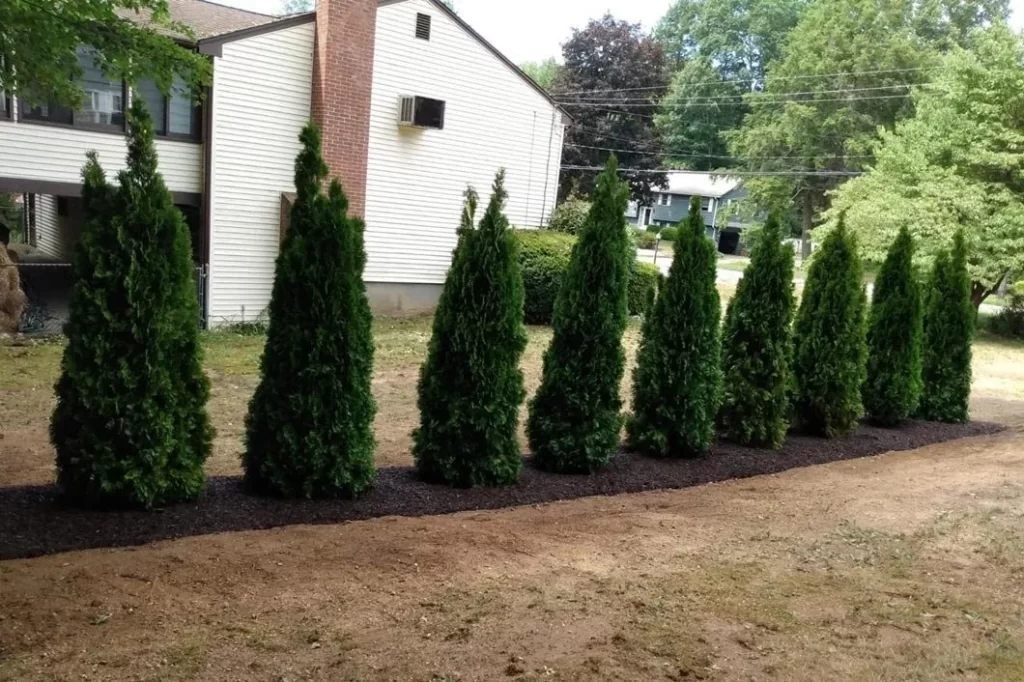It doesn’t need to be Earth Day or Arbor Day for you to think about planting a tree – in fact, just about any day is a good day to get your hands dirty with tree planting.
Trees do more than just improve the look of your property; they provide a host of benefits by providing shade, combating soil erosion, and releasing oxygen into the air.
While the process of tree planting might seem overwhelming, particularly if you’re not a self-professed green thumb, the reality is that it’s not as tricky as you might think.
Here are ten simple tips for tree planting – and what to do if you’d rather let someone else handle this task instead. Also, if you’re looking for tree removal instead of planting check out our done for you tree removal Southington page.

How Do You Plant a Tree? 10 Steps to Keep in Mind
Planting a tree is not rocket science, but it does require some planning and preparation. Here’s a helpful guide.
1. Locate and Mark Your Utilities
Before you begin the tree planting process, you need to know where your utilities are. This includes gas lines, electric lines, and water lines.
Contact your local utility company to have them come out and mark where your utilities are. This will ensure that you don’t accidentally hit any lines while you’re digging the hole for the tree, something that’s not only a hindrance to your project but also potentially life-threatening.
2. How Do You Prepare the Ground for Tree Planting?
The first step in preparing the ground for your tree planting is to assess your site. Consider the following factors: sunlight, soil quality, drainage, and placement.
Does your yard get plenty of sun or some shade? Is the soil loose and crumbly or packed and hard? Is drainage good, or do you have standing water in some areas?
Finally, where will you place your trees?
Will they be near structures or other plants? By answering these questions, you’ll have a better idea of what kind of trees will thrive in your yard and how to modify the soil to meet their specific needs.
After you’ve assessed your site, it’s time to prepare the soil. The most important step here is to ensure that the soil is well-draining. If the soil is too compacted or retains water, it can lead to root rot or other diseases that can kill your trees.
To combat this, loosen the soil to a depth of at least two to three feet and add organic matter like compost or manure. This will both improve drainage and add valuable nutrients to the soil that the trees need to grow and thrive.
3. Find the Trunk Flare
All trees have a thickened base where the trunk ends and the roots begin. The trunk flare is visible at the ground level of the tree if you locate it by assessing the tree’s size. The process is also known as “root collar excavation.”
Finding the trunk flare is critical to ensure that the tree grows correctly and healthily. Improperly planting a tree by burying the trunk flare can cause root rot or even deter tree growth.
4. How Deep Should You Plant a Tree?
After locating the trunk flare, you need to dig a hole deep enough to accommodate the tree’s roots but not too deep that the trunk gets buried.
A general rule of thumb is to dig a hole at least two times the width of the root ball. The hole depth should be no more than the height of the root ball.
Once you’ve dug the hole to the right depth, amend the soil with compost and organic matter. Then, place the tree in the center of the hole.
5. Remove the Tree from the Container and Put It in the Hole
It’s now time to remove the tree from the container and place it in the hole.
To do this, lay the pot on its side and gently slide out the root ball. If the tree’s roots appear to be circling callused in the container, use a sharp garden tool to cut any tangled or dead roots.
Position the tree’s root ball to fit the hole, making sure that the trunk flare is visible at the ground level.
6. Straighten and Align the Tree
Make sure the tree is straight by using a level. If the tree isn’t straight, adjust it by gently moving it. Use wooden stakes to help keep the tree in position if need be. Cover the roots with soil and press the soil down gently to compact it.
7. Backfill
Now that the tree is in place, you can backfill the hole with soil. Make sure you leave a shallow basin around the base of the tree. This will help in watering the tree. It’s important to remember that the soil should never be higher than the root flair level. Overfilling the soil can lead to defoliation and death of the tree.
8. Stake or Collar if Necessary
If your tree is tall or if you planted it in a windy area, you may need to use stakes to stabilize it. Hammer stakes firmly into the ground at an angle away from the tree. Then gently tie the straps around the trunk tying the strap around the stake.
Another alternative is using a collar. Place the collar around the trunk in the center. They provide stability to the tree and prevent breakage of the trunk.
9. Mulch Around the Base
Mulching is about so much more than just making a tree look pretty. It also helps with moisture control, helps prevent soil erosion, and regulates soil temperature.
Apply two to three inches of mulch around the base of the tree, making sure to keep it a few inches away from the trunk of the tree.
Using organic mulches like bark, wood chips, and leaves is preferable over colored mulch as they break down, adding nutrients to the soil as they decompose.
10. Care for Your Tree
Your tree is in the ground, and now it’s time to care for it. Trees need water and sunlight to grow, so regular watering and pruning are a must.
Water your tree at least once a week, more if you’re experiencing a drought. Prune your tree at least once a year to remove dead or damaged limbs. Keeping up with the proper maintenance of your trees will make them grow strong and healthy.
Need Help With Your Next Tree Planting Project?
Are you thinking of embarking on a tree planting project, but the mere thought of it makes you want to run for the hills? We’ve all been there. Planting a tree might seem like an easy task, but it can be an overwhelming project to undertake on your own.
But don’t worry, you don’t have to do it on your own! That’s where C&B Property Maintenance comes in.
Here at C&B Property Maintenance, we don’t just plant trees. We offer a full range of landscaping services, including design, maintenance, and installation.
Whether you’re looking to plant one or multiple trees, our seasoned professionals will help you figure out the best locations based on sunlight, soil, and drainage.
That way, your trees won’t just look amazing right after you’ve first planted them – but they’ll look fantastic for years to come. Contact us today for a free quote on your next tree planting project!

